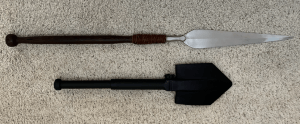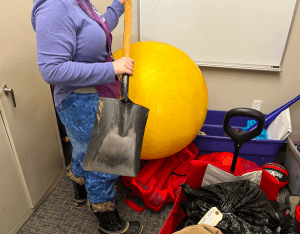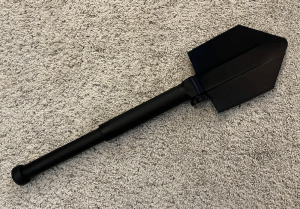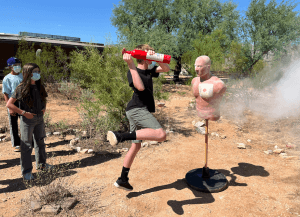Entrenching Tools in Close Combat

Clint Smith told us he preferred the shovel to the bayonet if one needed to take out an enemy at close quarters.
In the US military, shovels are called entrenching tools. Technically, a pickaxe (see Sam Woodfill below) is also used for digging trenches and foxholes, but “E-tool” refers, specifically, to a folding or collapsible shovel.
Remarque on E-tools
In his novel All Quiet on the Western Front, based on his own experiences in WWI, Erich Maria Remarque wrote of the preference for grenades and shovels when raiding an enemy trench:
“But the bayonet has practically lost its importance. It is usually the fashion now to charge with bombs and spades only. The sharpened spade is a more handy and many sided weapon; not only can it be used for jabbing a man under the chin, but it is much better for striking with becasue of its greater weight; and if one hits between the neck and shoulder it easily cleaves as far down as the chest. The bayonet frequently jams on the thrust and then a man has to kick hard on the other fellow’s belly to pull it out again; and in the interval he may easily get one himself. And what’s more the blade often gets broken off.”
–A. W. Wheen translation, Fawcett edition, p. 95
The Other E-Tool: Sam Woodfill’s determination
Within a week of Alvin York’s justifiably famous WWI exploits, Sgt (acting Lt) Sam Woodfill made an art of flanking and taking out German machine gun nests with his Springfield ’03, single-handedly killing over 25 of the Huns.
After briefly grappling with a German who tried to butt-stroke him at close range, Woodfill shot the German down with a .45 (probably an M1917 revolver). Woodfill then tried to finish the remaining Germans in an adjacent position with his .45, but ran out of ammo.
Undeterred, Woodfill picked up a German pick-axe and killed the last two.
Some collapsible E-tools have a fold-out spade on one side and an half pick-axe on the other. Either one could be devastating.
Bugs in Korea
Lt Col Anthony B. Herbert wrote, about one of his buddies in Korea:
“Bugs was MIA or dead. He had last been seen on a paddy dike east of Kun-mun-gol, out of ammo, swinging an entrenching tool as he went down under a pile of Chinese.”
—Herbert: The Making of a Soldier, p. 95
Vic Hernandez, and shovels in Hill Fights
Brian C, a fellow Thunder Ranch Old Rifle student, had a friend named Vic Hernandez, who spoke of E-tools being used for hand-to-hand combat in the hills near Khe Sanh.
Vic was a USMC embassy guard in Latin America when he volunteered for Vietnam. He wound up in the 3rd Recon Battalion in northwestern I Corps (the CTZs, Corps Tactical Zones, of South Vietnam were numbered with Roman numerals; “Eye” Corps was at the top of the map).
Khe Sanh was what we would now call a FOB, Forward Operating Base, named after a local village, near the northwestern-most corner of South Vietnam. A little background:
Dien Bien Phu had fallen in 1954 because the French had allowed the Viet Minh to take the high ground surrounding the fort.
Determined to prevent a repeat at Khe Sanh, the Marines had spent the spring of 1967 wresting control over the bunker-ridden hills NW of Khe Sanh (including Hills 881N, 881S, and 861A) from the NVAs (North Vietnamese Army). The Marines in Quang Tri Province had recently been issued their first M16s, before most of the bugs had been worked out, and they were beset by an inordinate number of stoppages (“jams”) in the middle of close range firefights. Consequently, bayonets, E-tools, and even 5-gallon water cans were sometimes used in what came to be known to Marines and military historians as “the Hill Fights.”
Knowing the loss of Khe Sanh could have been as devastating to American morale as the loss of Dien Bien Phu had been to the French, and wishing to re-create that success against our bastions near the DMZ, the NVAs were desperate to take those hills back. Charlie often got “inside the wire” of those outposts, especially in January of ’68. Knives, bayonets and e-tools again made a comeback.
Many fortified hamlets and outposts were overrun, or partially overrun, by the VC and NVA during the Vietnam war. When they were, hand-to-hand fighting was not uncommon. I found reference to E-tools being weaponized during the Hill Fights in a USMC history:
“. . . the defenders of the Alpha 1 [1st Battallion, 9th Marines, Company A, 1st Platoon] outpost fought desperate hand-to-hand encounters in the trenchlines, sometimes swinging entrenching tools . . .”
–Jack Shulimson, LtCol Leonard A. Blasiol (USMC), Charles R. Smith, and Capt David A. Dawson (USMC), US Marines in Vietnam: the Defining Year, 1968, Chapter 14, “The Siege of Khe Sanh,” p. 277
After his combat tour, Vic Joined the San Jose PD. He died as yet another victim of Agent Orange exposure. Before he did, the told Brian that the ranges were so close in the Hill Fights, Marines often had to rely on their flak jackets to protect them from their own grenades! They would toss them at the NVA a few feet away, then turn their backs and take the frags in their own legs and vests, knowing that the NVAs had no flak jackets.
Grenades were probably more important, and far more commonly used, bunker to bunker and foxhole to foxhole weapons, but (despite what Hollywood leads some to believe), hand grenades are not generally available to armed citizens in the US.
E-tools are a lot more general purpose, and more socially acceptable, than bayonets (or frag grenades). They are like a cross between an iKlwa and a battle axe.

So what?
While we can admire the indomitable fighting spirit of men like Bugs, and we should remember their sacrifices, I know some of you are wondering if this article reflects a morbid fascination with violence.
Bayonets, on the one hand, represent a collectible part of history, but E-tools . . . seriously?
In December of 2022 a special needs teacher asked me to tour her Life Skills classrooms and the surrounding parts of her school. My mission was to review physical security and give her suggestions for protecting her kids, several of whom are less mobile and less situationally aware than typical high schoolers.
In her storage room, I found a shovel they use for gardening.

Our perceptions create our reality. That teacher may have been required to read All Quiet on the Western Front in an undergraduate literature class. Many people do. But most who read it don’t dwell on the fact that Remarque remembered from his own experiences that many German trench raiders actually preferred the shovel to the bayonet when they were preparing for close range high intensity interpersonal violence.
Like most who live in our relatively safe, relatively civilized society, she is not likely to think of the shovel as a potential weapon when she is under life threatening stress–unless she has thought about it ahead of time. With a plan, and perhaps a little bit of practice on a pell, that teacher might not be as disarmed in school as potential predators might believe her to be.
If a punk with a machete chases her into that storage room, he might be in for a surprise.

Recommendations
Much of this article was excerpted from my review of Clint Smith’s Old Rifle course. Clint certainly preferred the E-tool–and the fire extinguisher–to the bayonet.

You should probably have an E-tool in each of your cars, as I do. I have used them to dig dirt, snow, and mud occasionally over the years.
Patton said that in combat, a mediocre plan executed with sufficient vigor and enthusiasm RIGHT NOW is better than the best plan executed later this week. If you are attacked while trying to shovel your car out of a snowbank, it may be faster and just as effective to defend yourself with the E-tool than it is to dig your concealed carry pistol out from under a heavy jacket and other layers of clothing.
This article is dedicated to soldiers like Sam, Vic, and Bugs, and their indomitable spirit. Try to channel their mindset in the unlikely event you’re ever attacked in your garage or garden shed, while you have a shovel within arms’ reach.
–George H, lead instructor, Heloderm LLC
